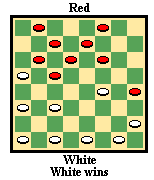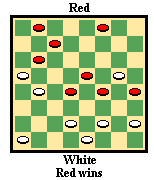Return to my Checkers pages
Go to my home page
Jim Loy-Brassey, 2002 ItsYourTurn.com, "Pro Checkers" Tournament
© Copyright 2002, Jim Loy
You may print this and show it to
others. But, this article will eventually be part of a book that I am writing.
So, please do not distribute it widely.
If you need help reading checkers notation, please print out the
numbered board.
This game was played on ItsYourTurn.com game service. Some of
the players use handles instead of their real names. This game should have been
a loss.
Jim Loy-Brassey, 2002 ItsYourTurn.com, "Pro Checkers" Tournament
11-15 23-18 12-16 ("Pro Checkers means 3-move, in this game service)
18-11 8-15 24-20 9-14 (In our other game, Red moved 16-19? which is a
published loss) 20-11 7-16 27-23 16-20 22-18 15-22 26-17 (25-9 is
published to draw, but this seems good too) 4-8 25-22 8-11 23-19 5-9
(2-7 draws) 17-13 (White seems to have a strong game) 2-7?(A,B)
[first diagram]
 22-17 (now or later) 11-15(C) 19-16? (29-25
wins because Red will soon run out of safe moves) 15-19 (I think other
moves lose) 30-26 (29-25 10-15 is tougher for Red) 10-15 (without
this move, Red would still be immobile and lost) 17-10 7-14 32-27 (29-25
is OK too) 14-18 21-17? (White falls into a trap which I did not notice
either. Other moves like 16-12 are strong) [second diagram]
22-17 (now or later) 11-15(C) 19-16? (29-25
wins because Red will soon run out of safe moves) 15-19 (I think other
moves lose) 30-26 (29-25 10-15 is tougher for Red) 10-15 (without
this move, Red would still be immobile and lost) 17-10 7-14 32-27 (29-25
is OK too) 14-18 21-17? (White falls into a trap which I did not notice
either. Other moves like 16-12 are strong) [second diagram]
 Do you see the Red win? Red continues: 9-14 17-10 19-23 26-19
15-24 28-19 6-24 (the material is even, but White will not be able to king
without giving up a piece) 16-11 24-28 27-24 (13-9 28-32 wins at least
one piece) 28-32 24-19 32-27 29-25 (19-15 1-6 wins the piece) 27-23
19-16 23-19 (I didn't see 18-22 25-18 23-14 16-12 14-18 RW) 16-12 19-16
11-8 16-11 8-4 18-23 etc. RW. The piece at 25 will be lost, once it gets to
10.
Do you see the Red win? Red continues: 9-14 17-10 19-23 26-19
15-24 28-19 6-24 (the material is even, but White will not be able to king
without giving up a piece) 16-11 24-28 27-24 (13-9 28-32 wins at least
one piece) 28-32 24-19 32-27 29-25 (19-15 1-6 wins the piece) 27-23
19-16 23-19 (I didn't see 18-22 25-18 23-14 16-12 14-18 RW) 16-12 19-16
11-8 16-11 8-4 18-23 etc. RW. The piece at 25 will be lost, once it gets to
10.
A - That was a losing move. See note B for a better move. Why is the
move a loser, when it worked just fine on the previous move? How can we avoid
making losing moves like this, when they look so innocent? The educational
answer to that last question is this: We cannot rely on general ideas like
"this move looks safe," or "this move looks strong." Instead, we must judge
moves by their consequences, both immediate and into the distant future. We
will soon see the consequences of my 2-7? Red's situation is very bad.
B - My computer says 10-15 may save the day: 10-15 19-10 6-15 13-6 1-10
looks bad. But Red has enough mobility (with 2-6 and 3-8) to fiddle around
while White's solid back row deteriorates.
C - Now do you see the terrible fix Red is in. We didn't have to look
very far into the future to see it, and avoid the losing 2-7?, either. Red's
entire position is immobile. 1-5 or 14-18 or 3-8 all lose. 11-15 loses too, but
it is the only move to delay defeat.
Return to my Checkers pages
Go to my home page
 22-17 (now or later) 11-15(C) 19-16? (29-25
wins because Red will soon run out of safe moves) 15-19 (I think other
moves lose) 30-26 (29-25 10-15 is tougher for Red) 10-15 (without
this move, Red would still be immobile and lost) 17-10 7-14 32-27 (29-25
is OK too) 14-18 21-17? (White falls into a trap which I did not notice
either. Other moves like 16-12 are strong) [second diagram]
22-17 (now or later) 11-15(C) 19-16? (29-25
wins because Red will soon run out of safe moves) 15-19 (I think other
moves lose) 30-26 (29-25 10-15 is tougher for Red) 10-15 (without
this move, Red would still be immobile and lost) 17-10 7-14 32-27 (29-25
is OK too) 14-18 21-17? (White falls into a trap which I did not notice
either. Other moves like 16-12 are strong) [second diagram] Do you see the Red win? Red continues: 9-14 17-10 19-23 26-19
15-24 28-19 6-24 (the material is even, but White will not be able to king
without giving up a piece) 16-11 24-28 27-24 (13-9 28-32 wins at least
one piece) 28-32 24-19 32-27 29-25 (19-15 1-6 wins the piece) 27-23
19-16 23-19 (I didn't see 18-22 25-18 23-14 16-12 14-18 RW) 16-12 19-16
11-8 16-11 8-4 18-23 etc. RW. The piece at 25 will be lost, once it gets to
10.
Do you see the Red win? Red continues: 9-14 17-10 19-23 26-19
15-24 28-19 6-24 (the material is even, but White will not be able to king
without giving up a piece) 16-11 24-28 27-24 (13-9 28-32 wins at least
one piece) 28-32 24-19 32-27 29-25 (19-15 1-6 wins the piece) 27-23
19-16 23-19 (I didn't see 18-22 25-18 23-14 16-12 14-18 RW) 16-12 19-16
11-8 16-11 8-4 18-23 etc. RW. The piece at 25 will be lost, once it gets to
10.